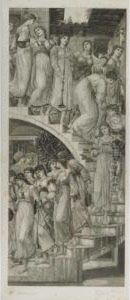Felix Stanislas Jasinski Paintings
Felix Stanislas Jasinski was a Polish artist, born in 1862 in Warsaw, then part of the Russian Empire due to the partitions of Poland. He emerged as a prominent figure in the late 19th and early 20th centuries, a period marked by significant political and social upheaval in Poland. Despite the national challenges, Jasinski pursued his passion for art, contributing to the Polish art scene's vibrancy and resilience.
Jasinski's artistic journey began at the Warsaw School of Fine Arts, where he honed his skills and developed a distinctive style that blended elements of Realism and Impressionism. His early work primarily focused on landscapes and scenes of daily life, capturing the spirit and struggles of the Polish people with sensitivity and depth. Jasinski's palette was often subdued, reflecting the somber mood of a nation under foreign rule, but his compositions were dynamic and infused with a sense of movement and life.
In the late 1880s, Jasinski continued his studies abroad, traveling to Paris, which was then the epicenter of the art world. This experience broadened his artistic horizons and introduced him to new styles and movements. The influence of French Impressionism is evident in his later works, which feature lighter colors, softer brushstrokes, and a focus on the effects of light and atmosphere. However, Jasinski never fully abandoned his roots, and his works continued to echo the themes of Polish identity and resilience.
Upon returning to Poland, Jasinski became actively involved in the artistic community, participating in exhibitions and contributing to the development of art societies. He was not just a painter but also an educator, sharing his knowledge and skills with the next generation of Polish artists. His commitment to art and education was a testament to his belief in the power of art to inspire change and foster a sense of national identity.
Felix Stanislas Jasinski's contributions to Polish art were cut short by his death in 1929. Despite his relatively brief career, he left a lasting legacy that continues to be celebrated in Poland and beyond. His works are housed in various museums and collections, serving as a window into the soul of a nation and the heart of an artist who captured the essence of his time.
